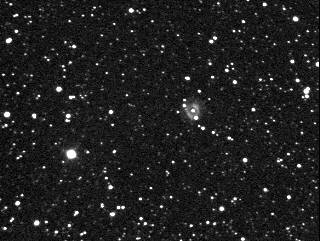Planetary Nebula NGC 6804

History
NGC 6804 was discovered on 25 August 1791 by William Herschel using his 18.7 inch reflector of 20 feet focal length. He cataloged it as VI 38 and wrote: «considerably bright, small, irregular faint, easily resolvable. Some of the stars are visible.» Herschel misclassified it. His class VI stood for «very compressed and rich clusters of stars» [465]
His son John cataloged it as h 2043 in his catalogue of 1833, still considering as a cluster, but thought he saw some nebula. He wrote: «Sweep 88: Doubtful if a resolved cluster or a nebula of first class. Pretty large, round, brighter in the middle, 60"; with 2 or 3 accidental stars of the Milky Way. Sweep 89: A cluster. Has a 16m star, one or two 18m, and nebula. Sweep 196: A very small roundish cluster, 40" diameter, of very small stars, one brighter than the rest and = 15m. It is like a nebula well resolved, and is a curious object. Sweep 280: A very small compressed fan-shaped cluster of stars 11...18m, diam=1'; a 11m star on the north following side forms the vertex of the fan.» [466]

In John Herschels «General Catalogue» of 1864 he referred to that curious object as GC 4499 and noted: «cB, S, iR, rrr» (considerably bright, small, irregular round, well resolved). [467] That description as adopted by John L. E. Dreyer for his 1888 release of the «New General Catalogue». [313] It was only in 1917 that Pease recognized that this mysterious object was a planetary nebula.[141]
Physical Properties
Distance information to the sun can be found from 878 to 1726 pc. [145]
| Designations | PN G045.7-04.5: NGC 6804, PK 45-04.1, ARO 34, VV 233, VV' 500 |
| Right Ascension (J2000.0) | 19h 31m 36s |
| Declination (J2000.0) | +09° 13' 38" |
| Dimensions | 35." (optical) |
| Distance | 1.1 kpc |
| Radial Velocity | -12.0 ± 3.8 km/s |
| Expansion Velocity | 24.0 (O-III) km/s |
| C-Star Designations | AG82 373, CSI +09 -19291, HD 183932, PLX 4568 |
| C-Star Magnitude | B: 14.47, V: 14.37 |
| C-Star Spectral Type | O9, O(H) |
| Discoverer | PEASE 1917 |
How to find NGC 6804?
The planetary nebula NGC 6804 is located in the constellation Aquila at about the same declination as Altair (α Aquilae). The 1° closeup from the DSS helps to identify the PN based on surrounding stars. On 14 July it is in opposition to the Sun and crosses the meridian at local midnight. Best observing time is from March to December.
Visual Observation

200 mm Aperture: The object appears in the 8-incher with a relatively weak surface brightness. Although the shape was initially difficult to discern, the nebula appeared as an asymmetrical, bell-like structure. The central star is west of a brighter star, visible against the faint nebula. The brighter neighboring star lies approximately at the visual nebula limit. — Celestron C8, 7. 8. 1996, Stefan Meister
